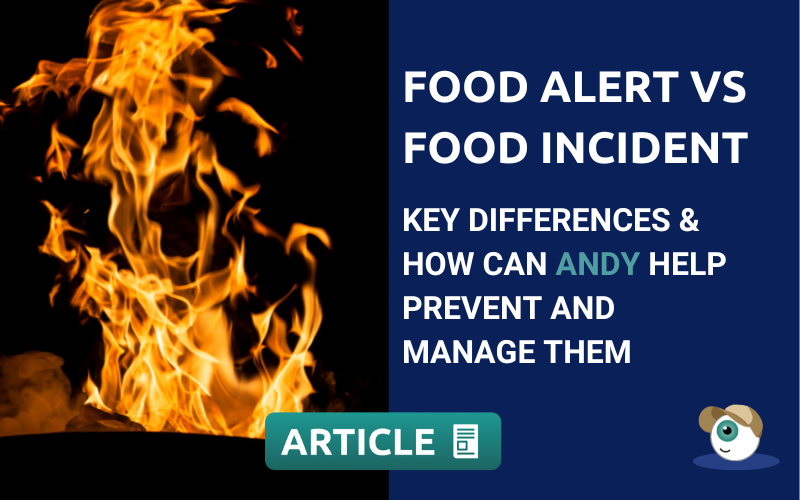Food Alert vs Food Incident: what’s the difference and how can Andy help prevent them

Is it a matter of the severity of the incident?
Is it linked to the type of trigger that causes one or the other?
Food alert vs food incident: differences and important details you need to know, explained in this post.
Read on!
Imagine food safety like a traffic light…
- Green light: All good! No risk of foodborne illness.
- Orange light: Beware! There’s a potential food safety issue, like a supplier recall or contamination concerns.
- Red light: STOP! A confirmed foodborne illness outbreak or serious safety threat requires immediate action.
Here’s the breakdown:
Food Alert: This is like the orange light. It’s a warning sign that something might be wrong with a specific food or ingredient.
Think recalls, potential contamination notices, or unusual foodborne illness reports. The information in an alert helps to raise awareness and prevent harm.
Food Incident: This is like the red light. It’s a confirmed problem that has already caused or could cause illness.
This could be an outbreak of foodborne illness, contamination confirmed in a food product, or a major accident affecting food safety.
Action is needed ASAP to stop the spread and protect consumers.
Key Differences between Food Alert vs Food Incident
- Severity: Alerts are potential problems, while incidents are confirmed problems.
- Urgency: Alerts require monitoring and caution, while incidents require immediate action and intervention.
- Impact: Alerts may affect consumer confidence, while incidents can cause illness and even death.
Remember:
- Alerts are early warnings to help prevent incidents.
- Incidents are serious situations that demand immediate action.
Being familiar with both alerts and incidents helps you stay informed and keep yourself and others safe when it comes to food.
What are the consequences of alerts and food crises for businesses?
Logically, any incident that endangers the health of the customer will have a negative impact on the financial health and the brand’s reputation.
However, even in catastrophic cases such as the American chain Chipotle, which sickened more than 1,100 people in the United States in various outbreaks between 2015 and 2018, it is possible to overcome a food crisis with proper communication.
But it is not easy.
In the case of Chipotle, the company had to pay a record $25 million to resolve criminal charges that include “violation of the Food, Drug, and Cosmetic Act by serving adulterated food that in some cases caused outbreaks of norovirus, which causes diarrhoea, vomiting, and abdominal cramps in restaurants,” the largest fine ever issued in the history of food safety in the United States!
“Today’s strong penalty, along with the tens of millions of dollars that Chipotle has already spent to update its food safety program since 2015,” explained federal prosecutor Nick Hanna, “should lead to greater protections for Chipotle customers and remind others in the industry to review and improve their own health and safety practices.”
The food crisis at Chipotle began when the first cases of E. coli were detected in restaurants of the well-known sustainable fast food chain, which forced the company to close more than 40 locations.
Despite the closures and the apparent reform of its food safety processes, cases of E. coli were detected again in several restaurants.
E.coli was joined by cases of norovirus and salmonella.
Its stock price plunged 40% in 2018 and the company lost 40% of its revenue.
And yet, Chipotle has come out ahead, has regained the trust of its customers, and is still serving.
Chipotle launched a greatly improved food safety program, which included testing the DNA of all its ingredients before they were sent to restaurants, changes in food preparation and handling practices, and paid sick leave to discourage sick employees from going to work.
The company also decided to double down on its unique value proposition: fresh ingredients and restaurant-style food preparation techniques that challenged its categorization as a mere “fast food chain.”
And above all, transparency and communication.
They even hired director Errol Morris to film a documentary-style ad that took consumers behind the scenes of Chipotle kitchens.
But, although we must applaud the company’s efforts to manage a food crisis of such colossal proportions, the best solution is never to reach those levels.
And the key lies in just one word: prevention.
Preventing and managing food safety incidents with Andy
Managing food safety incidents in restaurants and food service businesses is key to customer safety, but it’s a demanding endeavour!
Currently, there are two main approaches to preventing and managing food safety incidents: manual and automated.
Manual Control:
Manual control requires significant time and effort from restaurant staff.
It involves hazard analysis, identifying critical control points, setting limits, and establishing a recording protocol.
Other aspects like cleaning, pest control, maintenance, food handling practices, supplier approval, and traceability need management as well.
Automated Control:
Automated incident prevention and management comes in the form of a friendly digital food safety assistant – Andy.
This is how Andy can help preventing and managing food safety incidents:
- Reduce reaction time: Quickly respond to incidents.
- Minimise incidents: Decrease their occurrence.
- Streamline incident management: Simplify handling.
- Improve central oversight: Enhance awareness at headquarters.
- Cut red tape: Reduce documentation burden.
- Demonstrate responsiveness: Showcase HQ’s prompt action.
- Extend equipment lifespan: Prevent unnecessary breakdowns.
- Avoid unresolved issues: Ensure swift resolution.
- Enhance incident monitoring: Increase supervision.
- Boost response speed: Act faster when issues arise.
- Increase team coordination: Improve collaboration during incident resolution.
So, if you are ready to minimise food safety incidents and protect your customers…
Try Andy!
You’ll understand why so many other food service leaders around the world trust Andy from Starbucks to, Domino’s, Newrest, and many more
Start our 10-day free trial and prevent food safety incidents before they become a serious hazard to your customers’ health, and a nagging headache in your business!
👉🏽¡START YOUR FREE TRIAL HERE!👈🏽

